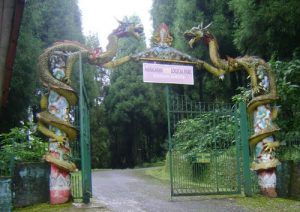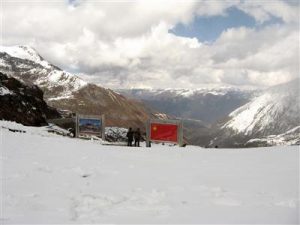Gangtok cannot be accessed by train routes.. The nearest train station is New Jalpaiguri (NJP) in Siliguri. Siliguri can be reached by train from Kolkata. It is an overnight journey and trains are frequent. From NJP the traveler is required to take an auto rickshaw to Siliguri state bus depot. From the state bus depot, buses depart for Gangtok. Private shuttle taxis are also available. The journey takes approximately six hours.
The prime attraction of Gangtok travel is the dazzling Himalayan scenery-dominated by the majestic stunning Kanchenjunga,the planet earth’s third highest mountain.
HOW TO REACH
By Air:-
The nearest airport to Gangtok is in Bagdogra, West Bengal. The distance between the two is around 124 km. The airport is connected with major cities in India. One can also avail helicopter services operated by the Sikkim Tourism Development Corporation daily from Bagdogra to Gangtok, which takes about 20 minutes.
By Rail:-
The nearest railway station to Gangtok is at New Jalpaiguri, West Bengal which is about 117 km from Gangtok. The New Jalpaiguri railway station is well connected with major cities and towns in India.
By Road:-
Gangtok is well connected by road with Siliguri, Darjeeling and Kalimpong by the National Highway 31A. There are regular Sikkim state transport buses between Gangtok and Siliguri. Private buses, jeeps and taxis can also be hired from Siliguri and Bagdogra. Gangtok is well linked with cities and towns in Sikkim and other neighboring states.
WHAT TO SEE
Tsomgo Lake:-
 Tsomgo Lake is located 35 km away from the city on the Gangtok-Nathula highway. This highway is also a part of the old route that links India and China. Worshipped by Sikkimese, this holy lake is approximately 20 km away from the Nathula Pass, while located at a distance of around 400 km from Lhasa. The water in this lake has been accumulated from the melting snow on the mountains located nearby. The river Lungtze Chu originates from this lake, which meets Rangpo-chu down its course. According to the history, the colour of water of this lake was studied by Lamas so as to forecast about the future. They believed, if the water had a dark tinge, it indicated an year full of trouble and unrest in the state.
Tsomgo Lake is located 35 km away from the city on the Gangtok-Nathula highway. This highway is also a part of the old route that links India and China. Worshipped by Sikkimese, this holy lake is approximately 20 km away from the Nathula Pass, while located at a distance of around 400 km from Lhasa. The water in this lake has been accumulated from the melting snow on the mountains located nearby. The river Lungtze Chu originates from this lake, which meets Rangpo-chu down its course. According to the history, the colour of water of this lake was studied by Lamas so as to forecast about the future. They believed, if the water had a dark tinge, it indicated an year full of trouble and unrest in the state.
Himalayan Zoological Park:-
 Himalayan Zoological Park, located at a distance of 3 km from Gangtok, is one of the best places for wildlife lovers. Situated in Bulbuley, the park has been established with the aim to preserve wildlife in natural habitat. Sprawling over an area of 205 hectares, the Zoological Park is at an altitude of 1,780 metre from where beautiful view of Mount Kanchenjunga can also be enjoyed. It is the first park of its kind in the entire north-eastern part of India, which was established in 1991. The animals residing in this park are kept in replicated natural conditions. Most part of this park is covered with forests of Red Panda, Blue Sheep, Musk Deer, Barking Deer and Himalayan Black Bear.
Himalayan Zoological Park, located at a distance of 3 km from Gangtok, is one of the best places for wildlife lovers. Situated in Bulbuley, the park has been established with the aim to preserve wildlife in natural habitat. Sprawling over an area of 205 hectares, the Zoological Park is at an altitude of 1,780 metre from where beautiful view of Mount Kanchenjunga can also be enjoyed. It is the first park of its kind in the entire north-eastern part of India, which was established in 1991. The animals residing in this park are kept in replicated natural conditions. Most part of this park is covered with forests of Red Panda, Blue Sheep, Musk Deer, Barking Deer and Himalayan Black Bear.
Deer Park:-
 Deer Park, located in close proximity to the Secretariat of Sikkim, is also known as Rustamji Park. Home to several species of Deer, this park was named after Rustamji. He was amongst one of the Dewans of the Chogyal of Sikkim. Rustamji, acclaimed himself to be the author of book ‘Enchanted Frontiers’.
Deer Park, located in close proximity to the Secretariat of Sikkim, is also known as Rustamji Park. Home to several species of Deer, this park was named after Rustamji. He was amongst one of the Dewans of the Chogyal of Sikkim. Rustamji, acclaimed himself to be the author of book ‘Enchanted Frontiers’.
Pemayangtse Monastery:-
 Pemayangtse Monastery, located at a distance of approximately 140 km from Gangtok, is one of the most famous pilgrimage centres. This monastery belongs to the Nyingma order and is situated at Gyalshing, located in West Sikkim. In addition, all the other monasteries belonging to Nyingma orders are located in Sikkim are subordinates to Pemayangtse Monastery.
Pemayangtse Monastery, located at a distance of approximately 140 km from Gangtok, is one of the most famous pilgrimage centres. This monastery belongs to the Nyingma order and is situated at Gyalshing, located in West Sikkim. In addition, all the other monasteries belonging to Nyingma orders are located in Sikkim are subordinates to Pemayangtse Monastery.
Nathula Pass:-

Nathula Pass, located at a distance of 56 km from Gangtok, is a pass on the Indo-Chinese border. Serving as a trade link between India and China, this park also once served as the main access for Sikkim-Tibet trade. Popularly known as the Silk Route, this pass is at an elevation of 14,450 feet and is rich in diverse alpine flora and fauna. The Nathula Pass is divided into terms ‘Nathu’ and ‘La’, which mean ‘listening ears’ and ‘pass’ respectively.
Enchey Monastery:-
 Enchey Monastery meaning solitary temple, was built in 1909 and is a 200 year old monastery. Located at a distance of 3 km from the city, the monastery is built on the spot, which is believed to be blessed by Lama Druptab Karpo. He was a tantrik master who was known for his flying powers. The monastery is also an important seat of the Nyingma sect of Tibetan Buddhism.
Enchey Monastery meaning solitary temple, was built in 1909 and is a 200 year old monastery. Located at a distance of 3 km from the city, the monastery is built on the spot, which is believed to be blessed by Lama Druptab Karpo. He was a tantrik master who was known for his flying powers. The monastery is also an important seat of the Nyingma sect of Tibetan Buddhism.
FOOD:-
Allow your taste buds relish a few momos while at Gangtok without fail for its a very popular food at the place. It is a steamed dumpling with beef, pork and cooked vegetables wrapped in dough and served with soup. Wa-Wai is yet another popular food made of noodles. And other noodle based popular foods available at Gangtok include Thupka, chowmein, thanthuk, Fakthu, wanton and gyathuk.